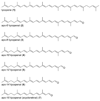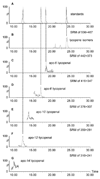Identification and quantification of apo-lycopenals in fruits, vegetables, and human plasma
- PMID: 20178389
- PMCID: PMC2851402
- DOI: 10.1021/jf100415z
Identification and quantification of apo-lycopenals in fruits, vegetables, and human plasma
Abstract
Research has suggested that lycopene may be metabolized by eccentric cleavage, catalyzed by beta-carotene oxygenase 2, resulting in the generation of apo-lycopenals. Apo-6'-lycopenal and apo-8'-lycopenal have been reported previously in raw tomato. We now show that several other apo-lycopenals are also present in raw and processed foods, as well as in human plasma. Apo-lycopenal standards were prepared by in vitro oxidation of lycopene, and a high-performance liquid chromatography-tandem mass spectrometry (HPLC-MS/MS) method using atmospheric pressure chemical ionization in negative mode was developed to separate and detect the apo-6'-, apo-8'-, apo-10'-, apo-12'-, apo-14'-, and apo-15'-lycopenal products formed in the reaction. Hexane/acetone extracts of raw tomato, red grapefruit, watermelon, and processed tomato products were analyzed, as well as plasma of individuals who had consumed tomato juice for 8 weeks. Apo-6'-, apo-8'-, apo-10'-, apo-12'-, and apo-14'-lycopenals were detected and quantified in all food products tested, as well as plasma. The sum of apo-lycopenals was 6.5 microg/100 g Roma tomato, 73.4 microg/100 g tomato paste, and 1.9 nmol/L plasma. We conclude that several apo-lycopenals, in addition to apo-6'- and -8'-lycopenal, are present in lycopene-containing foods. In addition, the presence of apo-lycopenals in plasma may derive from the absorption of apo-lycopenals directly from food and/or human metabolism.
Figures




References
-
- Giovannucci E. Tomatoes, tomato-based products, lycopene, and cancer: review of the epidemiologic literature. J. Natl. Cancer Inst. 1999;91:317–331. - PubMed
-
- Giovannucci E, Rimm EB, Liu Y, Stampfer MJ, Willett WC. A prospective study of tomato products, lycopene, and prostate cancer risk. J. Natl. Cancer Inst. 2002;94:391–398. - PubMed
-
- Nouraie M, Pietinen P, Kamangar F, Dawsey SM, Abnet CC, Albanes D, Virtamo J, Taylor PR. Fruits, vegetables, and antioxidants and risk of gastric cancer among male smokers. Cancer Epidemiol. Biomarkers Prev. 2005;14:2087–2092. - PubMed
-
- Sesso HD, Liu S, Gaziano JM, Buring JE. Dietary lycopene, tomato-based food products and cardiovascular disease in women. J. Nutr. 2003;133:2336–2341. - PubMed
Publication types
MeSH terms
Substances
Grants and funding
LinkOut - more resources
Full Text Sources

